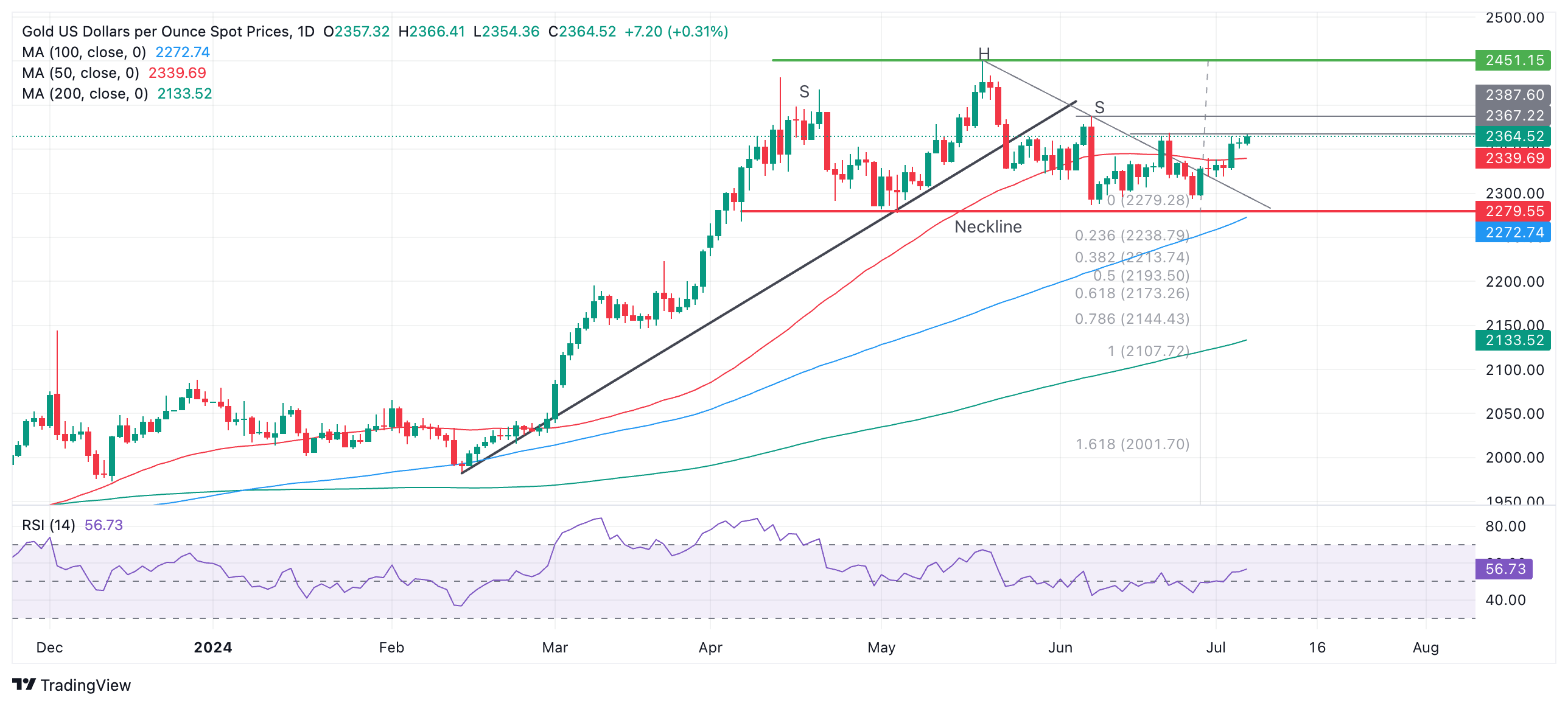- Gold extends its positive run as the probability of the Federal Reserve lowering interest rates increases.
- A run of weak data from the US indicates inflationary pressures are waning, and interest rates could fall.
- The US Dollar weakens, adding a backwind to Gold, as counterparts in Europe strengthen on diminishing political risk.
Gold (XAU/USD) rises on Friday, continuing its run of positive days as investors become increasingly optimistic the Federal Reserve (Fed) will lower interest rates sooner than previously thought, and the US Dollar (USD) softens, adding a lift to Gold which is predominantly bought and sold in Dollars.
Gold rallies as interest rates expected to fall, USD weakens
Gold trades in the $2,360s on Friday, up by more than a third of a percent on the day, as bets increase that the Fed will begin cutting interest rates as soon as its meeting in September.
A string of sub-par data releases from the US has dented confidence in the economy and increased speculation the Fed will move to lower interest rates in an attempt to spur growth. Weak labor market and services sector data has particularly impacted expectations. In light of this, Friday’s key labor report, the Nonfarm Payrolls release, is being touted as a significant data point in shaping expectations.
The probability of the Fed cutting its principal policy rate, the Fed Funds rate, by 0.25% by September has increased from the mid-60s at the start of the week to 72% on Friday, according to the CME FedWatch tool, which uses the price of the 30-day Fed Funds futures in its calculations. The promise of lower interest rates, in turn, increases Gold’s attractiveness as an investment because it lowers the opportunity cost of holding a non-interest-paying asset.
Gold gets a further backwind from a weaker US Dollar, which is falling because the expectation of lower US interest reduces foreign capital inflows, as well as because of a strengthening of its major counterparts. The Pound Sterling (GBP) is edging higher on Friday after a Labour Party landslide victory in the July 4 general election brings the promise of growth and stability. The Euro (EUR) is recovering on reduced political risk as it becomes increasingly clear the French far-right National Rally party will now probably not achieve a majority in the second round of elections on Sunday.
Gold gains on broader global backdrop
Gold is probably also benefiting from generalized demand as a result of broader geopolitical and macro factors.
The ongoing conflicts in the Middle East and Ukraine, as well as the increased risk of a Trump presidency, are still factors driving nervous investors to store their wealth in Gold.
The expansion of the BRICS trading bloc and its expressed aim to de-dollarize global trade has also increased demand for Gold, which is viewed as the most realistic replacement for countries denied access to Dollar-denominated markets because of sanctions.
Set against this, however, is falling political risk in Europe, which, despite a notable swing to the far right, is likely to remain in the hands of moderate coalitions.
High central bank demand, which accounts for roughly a quarter of the Gold market, might also be easing. Much buying was driven by Asian central banks using Gold as a hedge to support their domestic currencies as they depreciated against the US Dollar when it rallied in the spring, after the Fed had to revise its expectations for policy normalization.
Technical Analysis: Gold reaches resistance
Gold has now established itself comfortably above the 50-day Simple Moving Average (SMA), overcoming a major technical milestone for the yellow metal.
It has, however, reached a resistance level at swing high of the $2,368 June 21 high. A break above this level would add further confidence to a bullish view.
XAU/USD Daily Chart
A break above the June 21 high would unlock the next target at $2,388, the June 7 high, followed by the $2,451 all-time-high.
The bearish Head & Shoulders topping pattern that was forming between April and June has been invalidated by the recent recovery, however, that said, there is still a lesser chance that a more complex topping pattern is forming instead. If so – and price suddenly falls to the pattern’s neckline at $2,279 and breaks through it – a reversal lower may still follow, with a conservative target at $2,171, the 0.618 ratio of the height of the pattern extrapolated lower.
The trend is now sideways in both the short and medium term. In the long term, Gold remains in an uptrend.
Gold FAQs
Gold has played a key role in human’s history as it has been widely used as a store of value and medium of exchange. Currently, apart from its shine and usage for jewelry, the precious metal is widely seen as a safe-haven asset, meaning that it is considered a good investment during turbulent times. Gold is also widely seen as a hedge against inflation and against depreciating currencies as it doesn’t rely on any specific issuer or government.
Central banks are the biggest Gold holders. In their aim to support their currencies in turbulent times, central banks tend to diversify their reserves and buy Gold to improve the perceived strength of the economy and the currency. High Gold reserves can be a source of trust for a country’s solvency. Central banks added 1,136 tonnes of Gold worth around $70 billion to their reserves in 2022, according to data from the World Gold Council. This is the highest yearly purchase since records began. Central banks from emerging economies such as China, India and Turkey are quickly increasing their Gold reserves.
Gold has an inverse correlation with the US Dollar and US Treasuries, which are both major reserve and safe-haven assets. When the Dollar depreciates, Gold tends to rise, enabling investors and central banks to diversify their assets in turbulent times. Gold is also inversely correlated with risk assets. A rally in the stock market tends to weaken Gold price, while sell-offs in riskier markets tend to favor the precious metal.
The price can move due to a wide range of factors. Geopolitical instability or fears of a deep recession can quickly make Gold price escalate due to its safe-haven status. As a yield-less asset, Gold tends to rise with lower interest rates, while higher cost of money usually weighs down on the yellow metal. Still, most moves depend on how the US Dollar (USD) behaves as the asset is priced in dollars (XAU/USD). A strong Dollar tends to keep the price of Gold controlled, whereas a weaker Dollar is likely to push Gold prices up.

